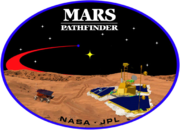Carl Sagan Memorial Station

Pathfinder and Sojourner at JPL in October 1996, being 'folded' into its launch position.
|
|
| Mission type | Lander · Rover (Mars) |
|---|---|
| Operator | NASA · Jet Propulsion Laboratory |
| COSPAR ID | 1996-068A |
| SATCAT no. | 24667 |
| Website | mars |
| Mission duration |
Pathfinder: 85 days Sojourner: 7 days |
| Spacecraft properties | |
| Launch mass |
Pathfinder: 264 kilograms (582 lb) Sojourner: 10.5 kilograms (23 lb) |
| Power |
Pathfinder: 35 W Sojourner: 13 W |
| Start of mission | |
| Launch date | December 4, 1996 06:58:07 UTC (21 years, 6 months and 1 day ago) |
| Rocket | Delta II 7925 (#D240) |
| Launch site | Cape Canaveral SLC-17 |
| Contractor | None |
| End of mission | |
| Last contact | September 27, 1997 10:23 UTC (20 years, 8 months and 9 days ago) |
| Mars lander | |
| Landing date | July 4, 1997 16:56:55 UTC (20 years, 11 months and 1 day ago) |
| Landing site |
Ares Vallis, Chryse Planitia, Mars 19°7′48″N 33°13′12″W / 19.13000°N 33.22000°W |
| Transponders | |
| Band | X-Band with high-gain antenna |
| Bandwidth | 6 kb/s to 70m Deep Space Network, 250 b/s to surface command |
|
|
|

Official insignia of the Mars Pathfinder mission.
Mars Pathfinder (MESUR Pathfinder) is an American robotic spacecraft that landed a base station with a roving probe on Mars in 1997. It consisted of a lander, renamed the Carl Sagan Memorial Station, and a lightweight (10.6 kg/23 lb) wheeled robotic Mars rover named Sojourner, which became the first rover to operate outside the Earth–Moon system.
Launched on December 4, 1996 by NASA aboard a Delta II booster a month after the Mars Global Surveyor was launched, it landed on July 4, 1997 on Mars's Ares Vallis, in a region called Chryse Planitia in the Oxia Palus quadrangle. The lander then opened, exposing the rover which conducted many experiments on the Martian surface. The mission carried a series of scientific instruments to analyze the Martian atmosphere, climate, geology and the composition of its rocks and soil. It was the second project from NASA's Discovery Program, which promotes the use of low-cost spacecraft and frequent launches under the motto "cheaper, faster and better" promoted by the then administrator, Daniel Goldin. The mission was directed by the Jet Propulsion Laboratory (JPL), a division of the California Institute of Technology, responsible for NASA's Mars Exploration Program. The project manager was JPL's Tony Spear.
...
Wikipedia
